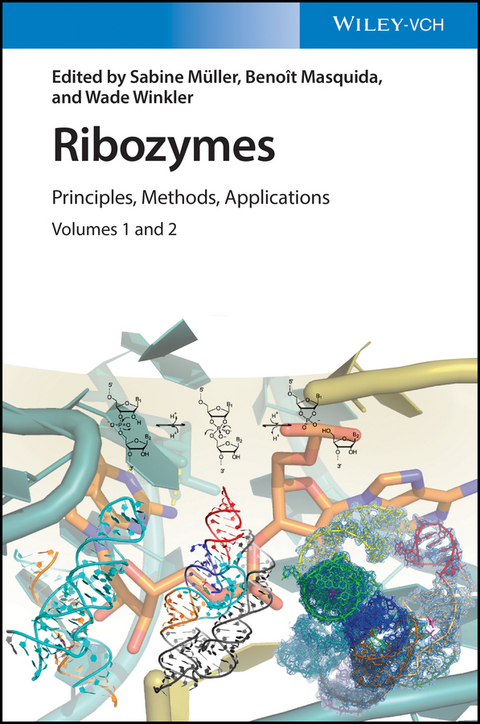Ribozymes
Wiley-VCH (Verlag)
978-3-527-34454-3 (ISBN)
'Ribozymes' is organized into six major parts. It starts by describing general principles and strategies of nucleic acid catalysis. It then introduces naturally occurring ribozymes and includes the search for new catalytic motifs or novel genomic locations of known motifs. Next, it covers the development and design of engineered ribozymes, before moving on to DNAzymes as a close relative of ribozymes. The next part examines the use of ribozymes for medicinal and environmental diagnostics, as well as for therapeutic tools. It finishes with a look at the tools and methods in ribozyme research, including the techniques and assays for structural and functional characterization of nucleic acid catalysts.
The first reference to tie together all aspects of the multi-faceted field of ribozymes
* Features more than 30 comprehensive chapters in two volumes
* Covers the chemical principles of RNA catalysis; naturally occurring ribozymes, engineered ribozymes; DNAzymes; ribozymes as tools in diagnostics and therapy, and tools and methods to study ribozymes
* Includes first-hand accounts of concepts, techniques, and applications by a team of top international experts from leading academic institutions
* Dedicates half of its content to methods and practical applications, ranging from bioanalytical tools to medical diagnostics to therapeutics
Ribozymes is an unmatched resource for all biochemists, biotechnologists, molecular biologists, and bioengineers interested in the topic.
Sabine Muller is Full Professor for Biochemistry/Bioorganic Chemistry at Greifswald University (Germany). Having obtained her academic degrees from Humboldt University Berlin, she spent one and a half years as a postdoc at the MRC in Cambridge (UK) and then took up a group leader position again at Humboldt University. After finishing her Habilitation in 2003, she moved to the Ruhr University Bochum, where she was a Professor for Bioorganic Chemistry, before taking up her present appointment at Greifswald in 2006. Professor Muller has received several scientific awards, including a Heisenbergstipendium of the Deutsche Forschungsgemeinschaft (DFG). She is a member of the Leibniz-Societat der Wissenschaften zu Berlin and of AcademiaNet. Benoit Masquida is a research director at Centre National de la Recherche Scientifique. After graduating from Universite Louis Pasteur in Strasbourg (France) working on the rules governing RNA folding, he spent one year at Yale University concentrating on ribosomal RNA structural motifs. After coming back to Strasbourg, he was appointed as a CNRS Research Scientist. He was promoted to Research Director in 2016, acknowledging his important contributions in the RNA structural biology field. Wade Winkler is an Associate Professor of Cell Biology and Molecular Genetics at the University of Maryland (USA). He acquired a graduate degree from The Ohio State University before spending three years as a postdoctoral researcher at Yale University. In 2004, he began his independent scientific career at The University of Texas Southwestern Medical Center in the Department of Biochemistry, and relocated his laboratory to the University of Maryland in 2011. Through the years, Professor Winkler has authored multiple influential publications on the different types of regulatory RNAs in bacteria.
INTRODUCTION
The chemical principles of RNA catalysis
NATURALLY OCCURRING RIBOZYMES
Biological roles of self-cleaving ribozymes
Chemical mechanisms of the nucleolytic ribozymes
The glmS ribozyme and its multifunctional coenzyme glucosamine-6-phosphate
The lariat capping ribozyme
Self-splicing group II introns
The Spliceosome: an RNA-Protein ribozyme derived from ancient mobile genetic elements
The ribosome and protein synthesis
The RNase P ribozyme
Ribozyme Discovery in Bacteria
Small self-cleaving ribozymes in the genomes of vertebrates
ENGINEERED RIBOZYMES
Phosphoryl transfer ribozymes
RNA replication and the RNA polymerase ribozyme
Maintenance of genetic information in the first ribocell
Ribozyme-catalyzed RNA recombination
Engineering of hairpin ribozymes for RNA processing reactions
Engineering of the Neurospora Varkud Satellite ribozyme for cleavage of non-natural stem-loop substrates
Chemical modifications in natural and engineered ribozymes
Ribozymes for regulation of gene expression
Development of flexizyme aminoacylation ribozymes and their applications
In vitro selected (deoxy)ribozymes that catalyze carbon-carbon-bond formation
Nucleic acid catalyzed RNA ligation and labeling
DNAZYMES
The chemical repertoire of DNA enzymes
Light-utilizing DNAzymes
Applications of DNAzymes in computing and nanotechnology.
RIBOZYMES AS TOOLS IN DIAGNOSTICS AND THERAPY
Optimization of antiviral ribozymes
DNAzymes as Biosensors
Compartmentalization-based technologies for in vitro selection and evolution of ribozymes and light-up RNA aptamers
TOOLS AND METHODS TO STUDY RIBOZYMES
Elucidation of ribozyme mechanisms at the example of the Pistol ribozyme
Strategies for crystallization of natural ribozymes
NMR spectroscopic investigation of ribozymes
Studying Ribozymes with Electron Paramagnetic Resonance Spectroscopy
Computational modeling methods for 3D structure prediction of ribozymes
| Erscheinungsdatum | 09.03.2021 |
|---|---|
| Verlagsort | Weinheim |
| Sprache | englisch |
| Maße | 170 x 244 mm |
| Gewicht | 2064 g |
| Themenwelt | Naturwissenschaften ► Biologie ► Biochemie |
| Naturwissenschaften ► Chemie ► Organische Chemie | |
| Schlagworte | Biocatalysis • Biochemie • Biochemie u. Chemische Biologie • biochemistry • Biochemistry (Chemical Biology) • Biokatalyse • Biowissenschaften • Chemie • Chemistry • Life Sciences • Ribozym |
| ISBN-10 | 3-527-34454-3 / 3527344543 |
| ISBN-13 | 978-3-527-34454-3 / 9783527344543 |
| Zustand | Neuware |
| Haben Sie eine Frage zum Produkt? |
aus dem Bereich




